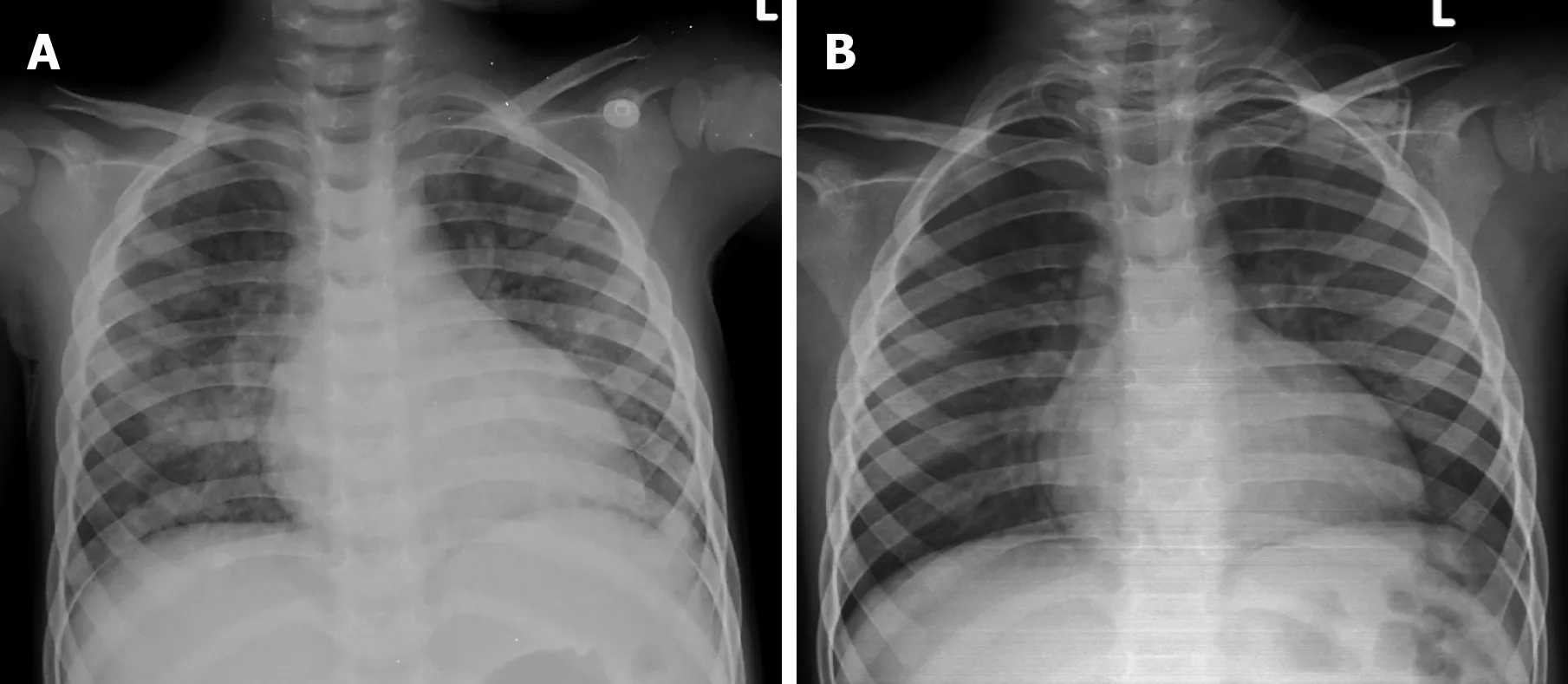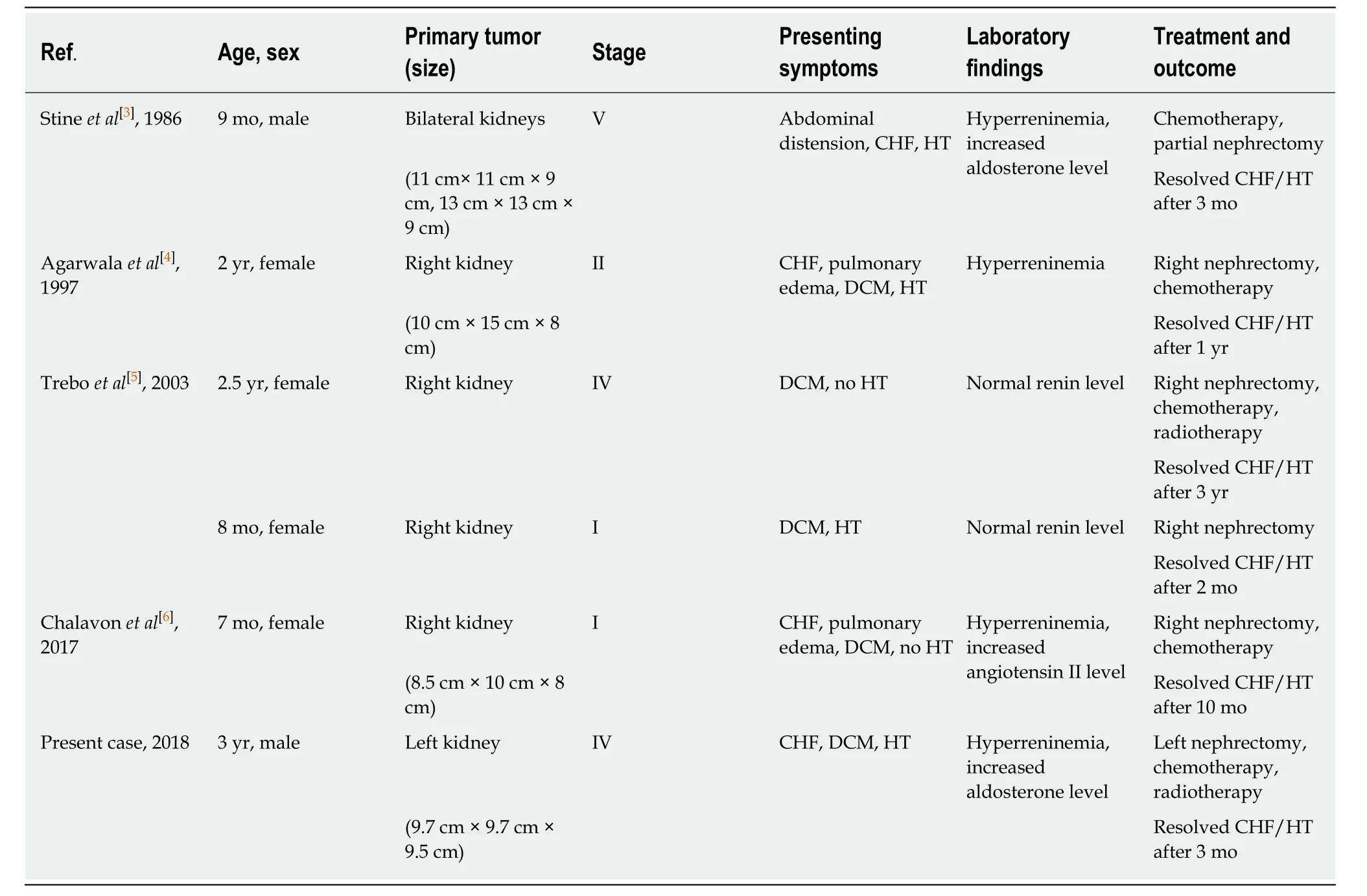Wilms tumor with dilated cardiomyopathy: A case report
Saviga Sethasathien,Chane Choed-Amphai,Kwannapas Saengsin,Lalita Sathitsamitphong,Pimlak Charoenkwan,Kanokkan Tepmalai,Suchaya Silvilairat
Saviga Sethasathien,Kwannapas Saengsin,Suchaya Silvilairat,Division of Cardiology,Department of Pediatrics,Faculty of Medicine,Chiang Mai University,Chiang Mai 50200,Thailand
Chane Choed-Amphai,Lalita Sathitsamitphong,Pimlak Charoenkwan,Division of Hematology and Oncology,Department of Pediatrics,Faculty of Medicine,Chiang Mai University,Chiang Mai 50200,Thailand
Kanokkan Tepmalai,Division of Pediatric Surgery,Department of Surgery,Faculty of Medicine,Chiang Mai University,Chiang Mai 50200,Thailand
Abstract
Key words: Dilated cardiomyopathy;Heart failure;Hypertension;Wilms tumor;Case report
INTRODUCTION
Wilms tumor,also known as nephroblastoma,is the most common renal malignancy in childhood and the second most common intraabdominal malignancy,accounting for 6% of all pediatric tumors. The age-adjusted incidence rate of Wilms tumor in Thailand is 2.7 per million[1]. Wilms tumor occurs primarily between the ages of 2 and 5 years[2],and the typical presentation is an asymptomatic abdominal mass. Other signs and symptoms are abdominal pain,hematuria,and hypertension;although,dilated cardiomyopathy and congestive heart failure are additional yet unusual presentations in patients with Wilms tumor,with only five cases reported previously[3-6]. On the other hand,pheochromocytoma could also be suspected in a patient with acute myocarditis or dilated cardiomyopathy and hypertension[7-10].Intracaval and intracardiac extension of the tumor thrombus is a cardiovascular complication occurring in 4%-10% of Wilms tumor[11-13]. This report describes a pediatric case of Wilms tumor with an unusual presentation of dilated cardiomyopathy with hypertension that was determined to be secondary to the tumor.
CASE PRESENTATION
Chief complaints
A 3-year-old boy presented with acute myocarditis and congestive heart failure.
History of present illness
The patient was hospitalized at a primary hospital,with a 5-d history of irritability,poor appetite,and respiratory distress. A chest radiograph revealed mild cardiomegaly and pulmonary infiltration. The patient was treated for bacterial pneumonia with a 3-d regimen of an oral antibiotic. He was then referred to a provincial hospital due to his symptoms not improving. His vital signs were as follows: heart rate of 144/min;respiratory rate of 65/min;blood pressure of 145/94 mmHg (right arm) and 144/102 mmHg (left arm),and of 169/90 mmHg (right leg)and 150/119 mmHg (left leg). He had dyspnea,tachycardia,hepatomegaly,and an oxygen saturation of 97%. Bilateral fine crepitations were audible over both lungs.Cardiac examination detected no murmur,regular rhythm,and normal first and second heart sounds,but also revealed an S3gallop. His liver was palpated 6 cm below the right costal margin.
A firm,non-tender mass was detected at the left upper quadrant of the abdomen,with the lower border at 8 cm below the left costal margin,and was suspected to be an enlarged spleen. A chest radiograph showed mild cardiomegaly and diffuse pulmonary infiltration. Electrocardiography noted a condition of sinus tachycardia and left ventricular (LV) hypertrophy. The two-dimensional and color Doppler echocardiography demonstrated presence of a hypokinetic LV wall with an ejection fraction of 29%,no mitral regurgitation,and normal coronary anatomy. The patient was diagnosed with acute myocarditis and treated with intravenous immunoglobulin,milrinone,furosemide,and spironolactone. He was referred to the Chiang Mai University Hospital (Chiang Mai,Thailand) because of the acute myocarditis,poor LV contractility,and hypertension.
History of past illness
The patient was reportedly healthy before the present illness.
Physical examination
The patient had hypertension and a mass at the left upper quadrant of the abdomen,with the lower border at 8 cm below the left costal margin and suspected to be splenomegaly.
Laboratory testing
On admission,the blood chemistry exam revealed normal renal function,elevated liver enzymes (aspartate aminotransferase 119 U/L,normal: 0-40 U/L;alanine aminotransferase 139 U/L,normal: 0-41 U/L),slightly elevated troponin T (50 pg/mL,normal: ≤ 14 pg/mL),elevated CKMB (6.1 ng/mL,normal: <4.8 ng/mL),and markedly elevated pro-B-type natriuretic peptide (21,736 pg/mL,normal: <300 pg/mL). Urinary analysis showed microscopic hematuria. The patient also had substantially elevated serum chromogranin A (156.9 ng/mL,normal: 31-94 ng/mL),plasma renin activity (34.75 ng/mL/h,normal: 0.06-4.69 ng/mL/h),and plasma aldosterone (961 pg/mL,normal: 20-180 pg/mL). The urinary level of metanephrines was within normal range (56.15 μg/d,normal: 25-312 μg/d).
Imaging examination
A chest radiograph revealed cardiomegaly with a cardiothoracic ratio of 60% and diffuse small pulmonary nodules (Figure1A). Echocardiography was performed to determine the cause of the acute myocarditis and hypertension. A dilated left ventricle with poor contractility (LV ejection fraction of 30%) and an 8 cm × 9 cm left renal mass were demonstrated (Figure2). Chest and abdominal computed tomography (commonly referred to as CT) scans delineated the existence of a large lobulated heterogeneously hypoenhancing 9.7 cm × 9.7 cm × 9.5 cm soft tissue mass occupying the left kidney,with intralesional necrotic and non-enhancing cystic portions (Figure3A). In addition,a thrombus in the left renal vein,ascites,multiple pulmonary nodules,and mediastinal lymphadenopathy were noted. Wilms tumor with lung metastasis was suspected.
FINAL DIAGNOSIS
A core needle biopsy of the mass was performed to confirm the diagnosis. The tissue histology revealed the triphasic pattern of Wilms tumor and absence of anaplasia.
TREATMENT
The patient received intravenous milrinone,furosemide,spironolactone,enalapril,amlodipine,and prazosin for treatment of the LV dysfunction with congestive heart failure and hypertension. Also,low molecular weight heparin was administered for treatment of his left renal vein thrombosis. Neoadjuvant chemotherapy (using a regimen of etoposide and carboplatin) was initiated.
OUTCOME AND FOLLOW-UP
Chest and abdominal CT scans after the first course of chemotherapy revealed a decrease in size of the tumor mass and newly developed pulmonary embolism in the left descending artery supplying basal segments of the left lower lobe. However,the patient showed no sign of deterioration. The planned radical nephrectomy was postponed because of the patient’s very large tumor mass,ascites,and pulmonary embolism. After three courses of chemotherapy,the tumor mass decreased in size,measuring 5.7 cm × 5.1 cm × 5.8 cm in the axial and vertical diameters,respectively(Figure3B). A chest radiograph revealed mild cardiomegaly with a cardiothoracic ratio of 55% and absence of pulmonary nodules (Figure1B). A chest CT scan showed marked decrease in the size and number of pulmonary nodules.

Figure1 Chest radiographs. A: At initial presentation,cardiomegaly with a cardiothoracic ratio of 60% and diffuse small multiple pulmonary nodules was detected;B: After three courses of chemotherapy,cardiomegaly with a cardiothoracic ratio of 55% and absence of pulmonary nodules was detected.
At 3 mo after the initiation of treatment,the patient had no clinical evidence of congestive heart failure. Echocardiography demonstrated improved LV contractility,with an ejection fraction of 50%. An adjuvant chemotherapy comprising dactinomycin,vincristine and doxorubicin was administered. The left radical nephrectomy was then performed at 4 mo after the diagnosis (Figure4). The postoperative histopathological report confirmed Wilms tumor with triphasic pattern and absence of anaplasia. After surgery,the patient underwent radiation therapy to the whole lung and left flank,while the adjuvant chemotherapy was continued. His plasma renin decreased to a normal level (2.83 ng/mL/h);blood pressure normalized and echocardiography showed good LV contractility,with an ejection fraction of 58%.
DISCUSSION
This present case had an unusual presentation of dilated cardiomyopathy and hypertension secondary to Wilms tumor. Dilated cardiomyopathy and congestive heart failure are rare presenting signs and symptoms of Wilms tumor,of which there have been only five reported cases previously[3-6]. All of the reported cases,along with our case presented herein,are summarized in Table1. Hypertension accompanied by dilated cardiomyopathy was noted in three of the five previously reported patients with Wilms tumor. Also,three of the five previously reported cases showed hyperreninemia with hypertension and congestive heart failure. Trebo et al[5]reported two cases of Wilms tumor with dilated cardiomyopathy and absence of hyperreninemia. The authors postulated that vasoactive mediators other than renin being produced from the Wilms tumor as the cause of the dilated cardiomyopathy without hypertension or elevated renin. The removal of the Wilms tumor alleviated the deterioration of the cardiac function in both of those previous cases.
Systemic hypertension secondary to high serum renin is common. Two hypotheses have been proposed for the etiology of hyperreninemia,including a mechanical compression of the renal artery leading to renal ischemia and a production of renin by the Wilms tumor[14-16]. In our case,the tumor mass displaced the left renal vessels,with a gross invasion causing a filling defect of thrombus in the left renal vein that was likely the cause of the elevated serum renin. The hyperreninemia resulted in increased angiotensin II,aldosterone and vasoconstriction,as well as fluid retention,all leading to hypertension and dilated cardiomyopathy. In addition,several studies have demonstrated that angiotensin II plays an important role in cardiac remodeling and dysfunction,regardless of the hemodynamic abnormality[17-19]. After treatment with chemotherapy,the size of our patient’s tumor mass decreased and the LV function gradually improved. In addition,his LV contractility returned to normal after the left radical nephrectomy.

Figure2 Echocardiography. A: A dilated left atrium and a left ventricle with poor contractility were noted;B: A 8 cm× 9 cm left renal mass with multilocular renal cyst appearance was seen.
Wilms tumor is characterized by a tendency to invade blood vessels. Extension of a tumor thrombus along the renal vein into the inferior vena cava and right atrium occurs in 4%-10% of all patients with Wilms tumor[11-13]. In the present case,the thrombus was noted in the left renal vein and a pulmonary embolism developed in the left descending artery supplying basal segments of the left lower lobe.Furthermore,Wilms tumor can cause hematogenous metastasis to the lymph nodes,lung,liver,bone,or brain. The case presented herein represented Wilms tumor stage 4 with multiple pulmonary metastases and mediastinal lymphadenopathy.
CONCLUSION
An abdominal mass with or without hematuria and hypertension is a common presentation,whereas dilated cardiomyopathy is an uncommon presenting symptom in patients with Wilms tumor. Wilms tumor should be included in the differential diagnosis of any patient,particularly pediatric,with dilated cardiomyopathy and an abdominal mass,regardless of the presence of hypertension. In a patient with acute myocarditis or dilated cardiomyopathy with hypertension in which other causes of hypertension are not identified,an abdominal ultrasound should be performed.

Table1 Clinical characteristics,laboratory findings,treatment and outcome in patients with Wilms tumor and dilated cardiomyopathy

Figure3 Computed tomography scan of the abdomen. A: At initial presentation,a large lobulated heterogeneously hypoenhancing 9.7 cm × 9.7 cm × 9.5 cm soft tissue mass occupying the left kidney was detected;B: After three courses of carboplatin and etoposide,the tumor was found to have decreased in size to measure 5.7 cm × 5.1 cm × 5.8 cm.

Figure4 A Wilms tumor of 3.5 cm × 4 cm × 7.5 cm confined to the renal capsule with hemorrhagic necrosis of tumor cells was removed.

